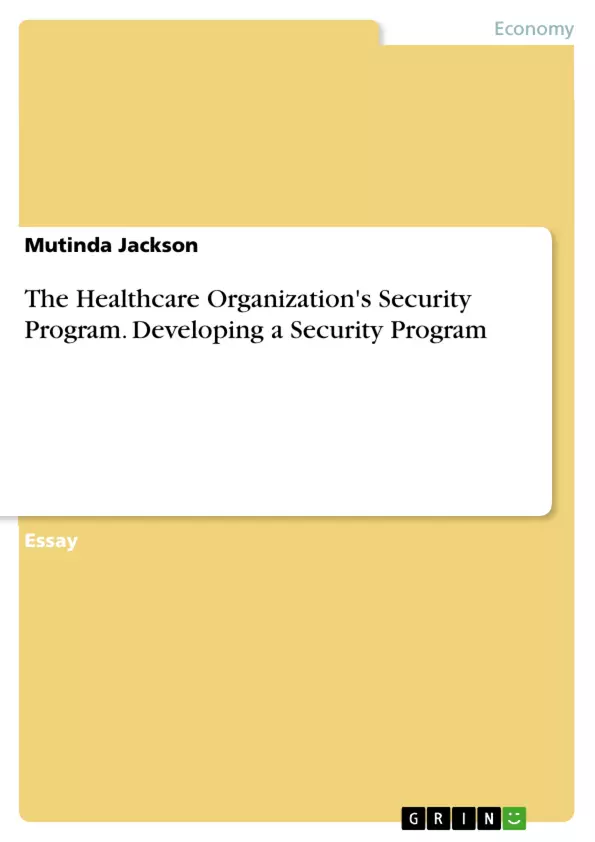Significantly, the manifold areas of any institution’s security program have for years been observed to play a vital part in aiding the certification and accreditation process of the information assets of that particular company. In this respect, any organization’s information security program is adequately made up by these supporting areas in alignment with both C&A and the post C&A activities. Sensibly, it remains mandatory for an individual to have a plan so as to make sure that his/her information assets’ security, regardless of the size of the organization ; an aspect termed as a security information program. The process involved in creating a security program makes an individual think holistically concerning his/her company’s security, regardless of the length of the plan. Typically, a security program offers the structure to keep an individual’s business at a desired security level; a phenomenon that occurs through risks assessment faced, presenting sound decisions on how to mitigate these risks along with planning the manner through which one keeps the program and the security practices up-to-date. Substantially, data is the predominant value of any organization; the company’s data is the key asset that any security program will aid in protection not to mention that the business’ value rests in its data, an aspect clearly evident in organizations whose information management is controlled by governmental and other regulations, for instance, managing credit card information of the customers. On the other hand, in cases where data management practices are yet to be covered by regulations, the values of the following have to be considered: product information, financial data and customer information. Data protection refers to protecting the information’s confidentiality, integrity as well as its availability, thus; failure of protecting these three aspects results in business loss, loss of the organization’s goodwill and even legal liability.
Inhaltsverzeichnis (Table of Contents)
- Introduction
- Team Selection
- Documentation
- Security Risk Analysis
- Action Plan
- Managing and Mitigating Risks
Zielsetzung und Themenschwerpunkte (Objectives and Key Themes)
This text examines the essential components of a comprehensive security program for healthcare organizations, emphasizing the importance of safeguarding patient data and maintaining operational integrity. It explores the critical elements that ensure a robust and effective security framework, highlighting the complexities and challenges faced by security professionals in this dynamic environment.
- The vital role of a security program in protecting sensitive information assets
- The importance of comprehensive risk analysis and mitigation strategies
- The impact of regulatory compliance on healthcare security practices
- The need for a strong organizational culture of security awareness
- The critical role of documentation and reporting in security management
Zusammenfassung der Kapitel (Chapter Summaries)
- Introduction: This chapter establishes the fundamental importance of information security programs in safeguarding organizational data and maintaining compliance with certification and accreditation (C&A) processes. It highlights the key elements of a robust security program, including risk assessment, mitigation strategies, and ongoing program updates.
- Team Selection: This chapter emphasizes the crucial role of a designated security officer (DSO) in coordinating and executing the organization's security program. It highlights the importance of establishing clear policies and procedures, promoting security awareness, and implementing robust incident-handling procedures.
- Documentation: This chapter underscores the significance of comprehensive and effective documentation as a fundamental component of a successful security program. It highlights the need for maintaining essential medical records and reports, ensuring the accuracy and completeness of the documentation system.
- Security Risk Analysis: This chapter delves into the critical aspects of risk assessment, defining threats and vulnerabilities, and analyzing the potential impact of security breaches on the organization. It emphasizes the importance of proactive risk mitigation strategies and the need to prioritize and manage risks effectively.
- Action Plan: This chapter outlines the development of a comprehensive action plan that encompasses compliance with both internal and external regulations and standards. It discusses the specific regulatory frameworks that may influence healthcare security practices, such as HIPAA, FISMA, and PCI.
- Managing and Mitigating Risks: This chapter explores the methodologies and best practices for managing and mitigating identified risks. It discusses the importance of adhering to industry standards, such as those provided by NIST, to ensure the confidentiality, integrity, and availability of data assets.
Schlüsselwörter (Keywords)
The text focuses on key terms like information security programs, risk assessment, mitigation strategies, regulatory compliance, security awareness, incident-handling, data protection, confidentiality, integrity, availability, designated security officer (DSO), healthcare organizations, HIPAA, FISMA, and PCI.
- Citar trabajo
- Dr. Mutinda Jackson (Autor), 2017, The Healthcare Organization's Security Program. Developing a Security Program, Múnich, GRIN Verlag, https://www.grin.com/document/437927



